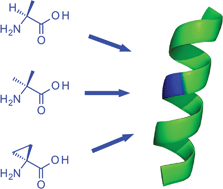Helix propensities of conformationally restricted amino acids. Non-natural substitutes for helix breaking proline and helix forming alanine
Abstract
Alpha helices are useful scaffolds to build biologically

* Corresponding authors
a
Department of Biochemistry and Molecular and Cellular Biology and BIFI, Universidad def Zaragoza, Pedro Cerbuna 12, 50009 Zaragoza, Spain
E-mail:
jsancho@unizar.es
Fax: +34 976762123
b
Department of Organic Chemistry, ICMA, Universidad de Zaragoza-CSIC, Pedro Cerbuna 12, 50009 Zaragoza, Spain
E-mail:
cativiela@unizar.es
Fax: +34 976761210
c
Barcelona Supercomputing Center, Jordi Girona 29, 08034 Barcelona, Spain
E-mail:
juanf@bsc.es
Fax: +34 934137721
Alpha helices are useful scaffolds to build biologically

 Please wait while we load your content...
Something went wrong. Try again?
Please wait while we load your content...
Something went wrong. Try again?
M. Alías, S. Ayuso-Tejedor, J. Fernández-Recio, C. Cativiela and J. Sancho, Org. Biomol. Chem., 2010, 8, 788 DOI: 10.1039/B919671D
To request permission to reproduce material from this article, please go to the Copyright Clearance Center request page.
If you are an author contributing to an RSC publication, you do not need to request permission provided correct acknowledgement is given.
If you are the author of this article, you do not need to request permission to reproduce figures and diagrams provided correct acknowledgement is given. If you want to reproduce the whole article in a third-party publication (excluding your thesis/dissertation for which permission is not required) please go to the Copyright Clearance Center request page.
Read more about how to correctly acknowledge RSC content.
 Fetching data from CrossRef.
Fetching data from CrossRef.
This may take some time to load.
Loading related content
